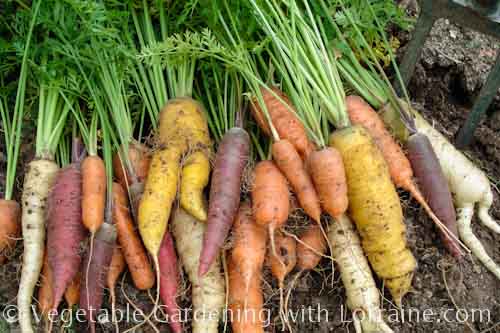- Home
- How to Grow Vegetables A-Z
- Growing Carrots
Growing Carrots
One of the biggest rewards of growing carrots yourself is being able to choose varieties that have intense carrot flavor, special sweetness, or interesting shapes or colors. Carrots are one of the most popular root vegetables - they are delicious when little, and get even tastier as they grow. Many people intentionally plant carrot seeds too close together so they can harvest and eat the thinnings.
 Rainbow Carrots
Rainbow Carrots|
The most common problem in growing carrots seems to be poor germination. I get a lot of questions about this. Usually the problem isn't actually poor germination itself (as in, “bad seed”), but rather that seeds start to germinate, and then dry out and die before they break the surface. The tiny sprouting seeds can also die if the soil is too hard to push though, or if they get watered with too much force and become exposed on the surface. Watering with soaker hoses, fine-spray sprinkers or a fine mist by hand are all better during germination than heavy overhead watering. Soil PreparationLet’s back up a bit and talk about soil in general. Carrots, having such long, straight taproots, need to be planted in a very fine seedbed that is very loose, friable and stone-free down at least a foot, though two is even better. If carrots encounter little stones or other impediments, they will fork rather than try to grow around it. (Now, to prevent this page from becoming too long, I have divided it into topics. To continue reading, click the link below that matches what you want to know:) |
Growing Carrots:The Bare Facts Start Indoors: carrots don’t transplant well. Direct-seed in ground 2-3 weeks before last frost. Plant Seeds: ¼” deep (or on surface, covered with 1/4" fine compost), 3” apart (or closer, then thin). Transplant: don’t. Direct seed instead. Thin: to 2” apart when 2” tall, to 3” apart when 3” tall. Crowding causes forking. Days to Maturity: 70-80 days to harvest Type of soil: deep, loose, stone-free Nutrition: a LOT of compost, a teeny bit of phosphorus and potassium, no added nitrogen Harvest: loosen gently with fork near row, pull carrots gently. Harvest on time or roots will crack Special Info: choose shorter, stumpier varieties if you have stony or clay soil |
|
Techniques to ensure germination and maximize use of space. |
My best advice is don't. But if you must, here's one way that sorta works. |
How to deal naturally with the most common carrot problems. |
|
Carrots must be harvested correctly in order to store well. |
How to prep carrots for long-term storage so they will keep for several months. |
And one of the most fascinating websites you'll ever find devoted to only one vegetable is the World Carrot Museum, a labor of love by a devoted Englishman named John, who is a tremendous resource of carrot lore. It's a fun place to visit!
Help share the skills and spread the joy
of organic, nutrient-dense vegetable gardening, and please...
~ Like us on Facebook ~
Thank you... and have fun in your garden!
Affiliate Disclaimer
This website contains affiliate links to a few quality products I can genuinely recommend. I am here to serve you, not to sell you, and I do not write reviews for income or recommend anything I would not use myself. If you make a purchase using an affiliate link here, I may earn a commission but this will not affect your price. My participation in these programs allows me to earn money that helps support this site. If you have comments, questions or concerns about the affiliate or advertising programs, please Contact Me.Contact Us Page



